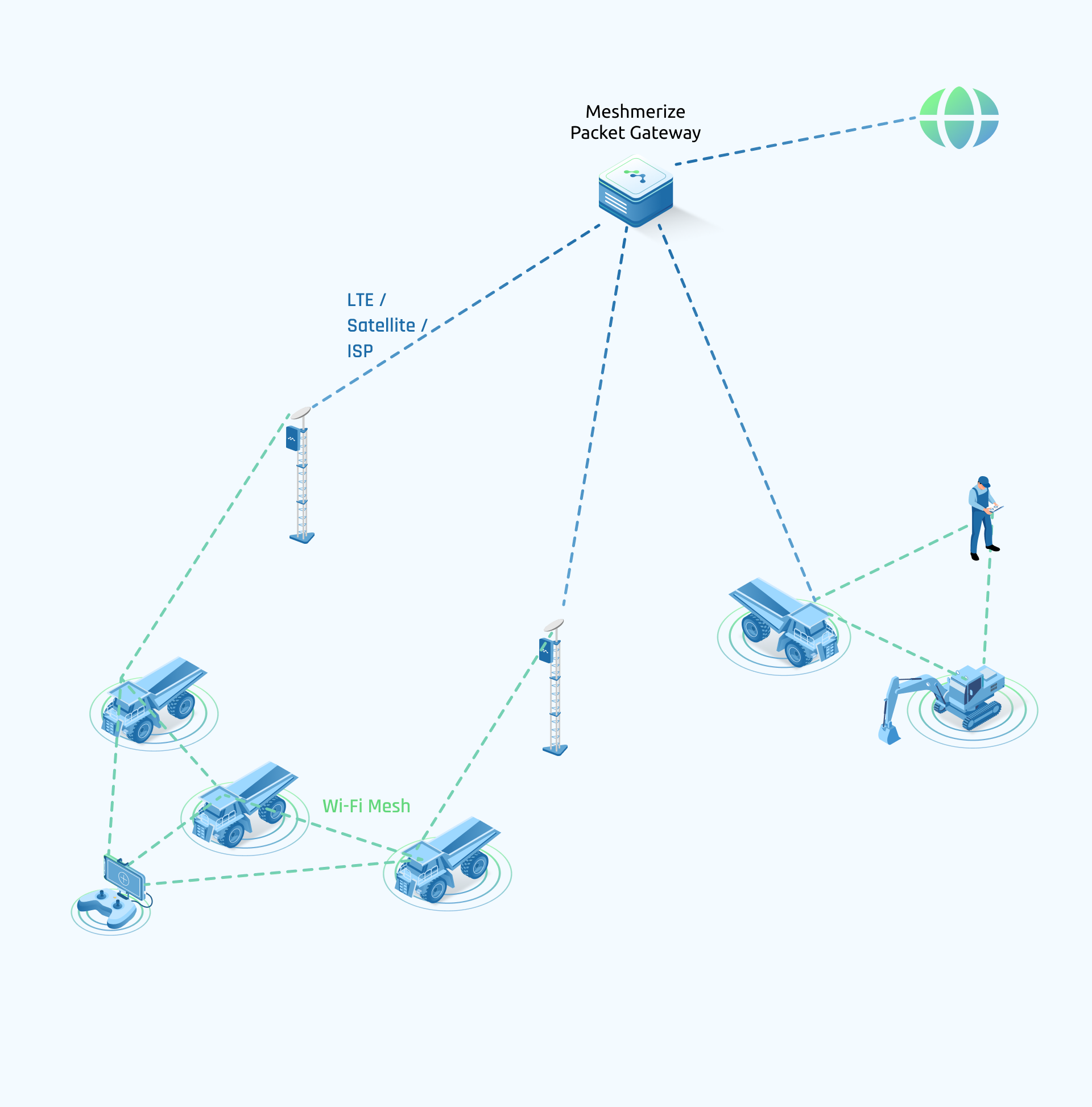¶ Meshmerize Packet Gateway Service - An overview
¶ Introduction: Beyond the Limits of a Single Network
Meshmerize can extend your network beyond Wi-Fi and LAN by integrating any form of uplink — from LTE/5G to satellite broadband (e.g. Starlink) or wired backhaul — directly into your network. This creates a unified, fully encrypted Layer 2 mesh network across local Wi-Fi, LAN and uplinks.
This document provides a technical overview of how Meshmerize leverages these uplinks not merely as backups, but as fully integrated parts of the network. The result is a hybrid mesh that intelligently combines the strengths of local Wi-Fi meshing with wide-area connectivity — creating a single, seamless, and exceptionally robust network for the most demanding environments.
¶ The Meshmerize Magic: How It Works Under the Hood
Meshmerize Networks can usually carry traffic in and out of the Wi-Fi mesh at multiple points. However, these networks need an additional component in order to be able to connect on a Layer 2 link with other parts of the mesh network that may be physically separated. The Meshmerize Packet Gateway performs the role of a hub node, that routes traffic between different physically isolated mesh nodes. The Meshmerize Packet Gateway acts as a secure ingress/egress point for traffic that needs to leave or enter the local mesh. It can run in the cloud or on-premises.

Crucially, Meshmerize treats all uplinks — LTE, Starlink, 5G or wired — as peers in its routing decisions. The gateway’s role remains the same regardless of the uplink medium: it terminates encrypted tunnels, measures link health and relays external traffic.
If a group of nodes loses all uplink connectivity, they continue to function perfectly as a self-contained local mesh, ensuring operational continuity.
¶ Link Establishment and Encryption
Meshmerize’s routing engine views every connection as a “link” with a dynamic quality score.
- Wi-Fi Links: Measured via beacon-based loss and signal metrics, optimized for the high variability of local wireless.
- Uplink Links (LTE/Starlink/Other):
- Meshmerize treats each uplink as a persistent Layer-2 connection to the Gateway.
- Because these are IP networks, Meshmerize encapsulates Layer-2 frames into UDP packets.
- Quality is measured primarily through latency and jitter, as packet loss is often hidden by lower-layer retransmissions.
- Each uplink (LTE, 5G, or Starlink) is scored independently, allowing Meshmerize to select the optimal path in real time.
All uplink traffic between nodes and the Meshmerize Packet Gateway is fully encrypted ensuring confidentiality and integrity across untrusted networks — whether cellular, satellite, or terrestrial.
¶ How It Adds Value: Key Use Cases
By treating uplinks such as LTE, Starlink or fixed broadband as additional paths in its routing calculus, Meshmerize unlocks powerful new deployment models.
¶ Use Case 1: Enhanced Reliability & Coverage Extension
Imagine a mining operation or a large agricultural site where uplink coverage (cellular, satellite or terrestrial) is good overall but inconsistent in specific locations. In a Meshmerize deployment, every node can be equipped with both Wi-Fi and an uplink interface (LTE modem, Starlink terminal or Ethernet WAN).
- Standard Operation: Nodes communicate over their preferred uplink for wide-area connectivity.
- The Meshmerize Advantage: When a node’s uplink degrades — e.g. LTE drops or a Starlink terminal loses line of sight — Meshmerize instantly and automatically reroutes traffic through Wi-Fi mesh links to a neighboring node with a stable uplink. The mesh transparently fills coverage gaps, ensuring continuous uptime.
¶ Use Case 2: Cost-Effective & Flexible Deployments
Equipping every device with its own uplink hardware and data plan can be expensive. Meshmerize enables a shared "gateway" model.
- The Architecture: A few nodes, strategically positioned, are equipped with uplink modems (LTE, 5G, or Starlink), acting as backhaul gateways. They are surrounded by numerous Wi-Fi-only nodes.
- The Meshmerize Advantage: The Wi-Fi-only nodes seamlessly route their traffic through the mesh to the nearest gateway node. This allows multiple devices to share a single uplink connection, drastically reducing hardware and operational costs while maintaining network reach and reliability.
¶ Frequently Asked Questions (FAQ)
Can a node use multiple uplinks simultaneously (e.g. LTE + Starlink)?
Yes. Each uplink interface is treated as a distinct link. Meshmerize measures and optimizes them independently, supporting failover and redundancy.
Is traffic encrypted over satellite or other IP links?
Absolutely. All uplink traffic is encapsulated in an encrypted tunnel, ensuring strong security regardless of the network medium.
What happens if all uplinks fail?
The mesh continues to function locally. Nodes remain fully operational and communicate internally until any uplink is restored.
Can external modems (via Ethernet) be used for Starlink or other uplinks?
Yes. Any Ethernet-connected device providing IP connectivity (e.g., Starlink terminal, 5G/LTE router) can be configured as an uplink interface.
Does Meshmerize need special provider configuration?
No. Meshmerize operates over any standard IP link — public, private or NATed — requiring no changes from the provider side.
¶ Conclusion
Meshmerize’s hybrid uplink integration transforms your network into a multi-backhaul mesh — equally capable over LTE, Starlink or any IP uplink.
By fusing local-area Wi-Fi resilience with diverse wide-area connectivity, Meshmerize delivers a network that is more adaptive, reliable and efficient than any single-technology solution. The complexity of link management is completely abstracted — empowering operators with effortless, always-on connectivity in even the most challenging environments.